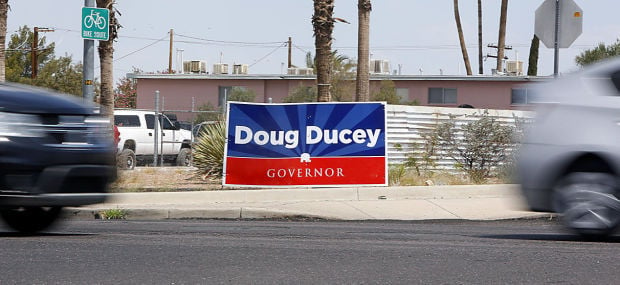PHOENIX — They’re often seen as simple affirmations of support by backers.
And some say they’re little more than visual blight.
But there’s a new report that shows those lawn signs for candidates that pop up before every election actually can sway a few votes — perhaps just enough to change the outcome of a close election. And that surprised the researchers who conducted the experiment.
Alexander Coppock, one of the five researchers in the projects, said he and his colleagues started with the presumption that those small signs are likely a waste of money by candidates.
“They’re probably just preaching to the choir,” said Coppock, a doctoral candidate in American Politics at New York’s Columbia University.
So they decided to test that theory by working with candidates in Virginia who agreed to let them put up extra 18-by-24-inch signs in some areas — above and beyond what the candidates had planned — but not in others. That included one statewide race and three local races.
And they chose the precinct to “treat” at random.
What they found, overall, was that the vote for the candidate who was sponsoring the signs — or in one case, against the candidate who was the target of a negative sign — was 1.7 percent higher in the “treated” precincts than it was in the others.
Potentially more significant, Coppock said there was no statistical difference in total voter turnout.
“But there was an effect on vote share,” he said.
“Our best guess is that the lawn signs actually persuaded people,” Coppock continued. “Instead of voting for one candidate, they voted for a different candidate.”
The “why” behind that, however, remains unclear — and subject to some future studies.
One of those, Coppock said, will be whether the placement of the signs is a factor. He speculates that those placed on the front lawns of homes have a more substantial effect than those simply placed in highway medians.
“One sort of says this person has specific support in this neighborhood,” he explained.
“Maybe I can infer about the kind of person that supports Donald Trump because it’s in a particular kind of neighborhood,” Coppock continued. “Or I could infer about who is supporting Hillary Clinton in my community by where they live.”
By contrast, he said, signs along the highway appear largely to promote name identification rather than actually persuade individuals to change their minds.
Arizona political consultant Constantin Querard, who works for Republican candidates — and uses yard signs — said the results of the study are not surprising.
And Querard said his own experience convinces him that Coppock and his colleagues are onto something in believing that where a sign is plays a role in its political effectiveness.
“If you have them scattered out on the highways and byways, they can be helpful from a name ID standpoint,” Querard explained. But he said they tend to disappear in a sea of similar signs.
Ditto, he said, for signs on street corners.
“On your street, maybe there’s one or two,” Querard said.
But it’s not even that simple. He said the higher the profile of the race — and the more people already know of candidates — the less politically useful a yard sign will be.
“If you put your yard sign out because you’re telling your friends you’re voting for Romney or you’re voting for Obama, you’re not trying to persuade people,” he said.
“It’s like putting a Cubs flag out when they’re in the playoffs,” Querard continued. “You’re just telling your neighbors which side you’re on.”
The dynamics are different, he said, on “down ticket” races, things toward the end of the ballot like state legislator or county assessor.
“These are races where your neighbors maybe aren’t tracking the race as close as you are,” Querard said.
“Your endorsement is valuable only because they assume you know the person or pay attention to this. And in the absence of any other deciding factor, the personal endorsement from your neighbor actually, I think, carries weight.”
Now, Querard admitted he can’t prove it.
“I don’t have any science to back me up,” he conceded.
Coppock said he hopes to provide that with the next study.
One thing the research did prove is that going negative apparently works.
He said three of the races studied each had positive signs for the candidates, while a fourth attacked a foe in another race.
“That’s where we saw the strongest effect,” Coppock said.
While he can’t specifically explain the difference, “it’s possible the negative signs were more memorable.”





